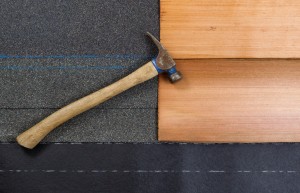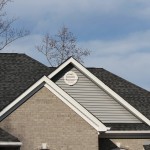
If your home or commercial property needs a new roof, you may be wondering what different types of roofing are available. Here, we’ll discuss the different types of roofing systems and material types that are available. Understanding the benefits and drawbacks of each roof type will help you make a smarter choice when it’s time to move forward.
Types of roofing: steep slope vs. low slope
There are two main classifications of roof systems: steep slope and low slope. The official distinction between the two is that low slope roofs won’t exceed 14 degrees; steep slopes, in contrast, are greater than 14 degrees. Low slope roofs are more common with commercial buildings, while steep slope roofs are seen more on residential properties.
Features of low-slope designs
Low-slope roofs, or “flat roofs” are becoming popular with homeowners as well as construction professionals building new homes. These roofs have varying prices and often come with a 10 to 20-year warranty, sometimes longer if they are maintained well and installed correctly.
Flat roofs bring different methods of repair and other considerations before you decide to replace it. They are more prone to leaks than traditional roofs, so it’s important that you pinpoint leaks and use the right foundational materials to repair them.
Low slope designs come in a grouping of subcategories:
Built-up Roof: One of the main benefits is it being fire retardant, as it consists of gravel. It is also the most inexpensive type of roof. These are composed of three or more types of waterproof material. These roofs will require special water drainage accommodations. These are heavy roofs and often require strengthened joists, so be sure that your roofing professional takes a close look at your home’s structure before you decide to install this type of roof.
Modified Bitumen: This is a single-ply rolled roof that is made of a peel and stick material. It is lightly colored and thus reflects heat well, which can help cut utility bills over time. It is priced mid-range, and it’s both safe and easy to install.
Rubber Membrane: This durable material looks like an inner tube and is built to resist sunlight damage. It is usually mechanically anchored with fasteners, ballasted with stone, or glued together. The material is light and holds up well against tears and scuffs. If there are any leaks, they are easy to patch. Given the strength of the material, this is a higher priced flat roof option.
Features of Steep-Slope Roofing
Just like low slope roofs, there are also a variety of subcategories for steep slope types of roofing. Each type of roofing brings its own features:
Asphalt: Asphalt is traditionally the most common material used, as it’s quite durable and relatively inexpensive.
Slate: Slate is incredibly durable, as it’s life expectancy can extend up to 100 years. Homeowners appreciate it as it gives an elegant look to the home.
Shakes/shingles: These are popular for reasons similar to asphalt, as they are durable and, most especially, resistant to decay.
Metal: Metal roofs bring a range of benefits, namely the fact that they are environmentally-friendly, have a long life expectancy and bring relatively minimal maintenance.
Pros and Cons of Low and Steep-Slope Roofs
Steep slope roofs
+ Steep slope designs are simpler to maintain, as debris rolls off easily
+ Steep slope roofs are perfect for homes with a traditional look
+ Allow the room under the roof to be used as an alternative use of space
– Need water-shedding features to reduce the risk of water permeation
– Sometimes more expensive than flat roofs, since they require more construction materials
Low slope roofs
+ Low slope roofs are waterproof
+ Can use the roof space for things like rooftop gardens, terraces or leisure areas
+ Allow for more use of available utility space below (which is why they’re so popular with commercial buildings)
– Debris can collect up top, and are more expensive to maintain
– Not always eligible to be constructed in certain areas
Things to consider when choosing roof material:
How Durable Is It?
Your new roof will cost a lot of money. Like all good long-term investments, it makes sense to find the material that will last as long as possible. Here are typical life spans for common roofing materials:
Asphalt shingles: 20-30 years
Laminated asphalt shingles: 30 years to lifetime
Wood shakes: 20 years
Metal, like aluminum, copper, steel, lead, and copper-and-asphalt: 50 years or more
Clay tile: 50 years or more
Slate: 100 to 150 years, or more
Plastic polymer: 50 years or more
Can My House Handle the Weight?
Materials vary significantly in how much load they put on your home’s structure. Some home frames are unable to sustain certain types of roofing materials. You’ll want to consult with a contractor about this as you choose the material. Here is a look at the weights of common roofing materials, per hundred square feet:
Asphalt shingles: 190 to 250 lbs.
Laminated asphalt shingles: 240 to 340 lbs.
Wood shakes: 300 to 400 lbs.
Metal: 50 to 270 lbs.
Tile: 900 lbs. or more
Slate: 900 lbs. or more
Plastic polymer: 70 to 300 lbs.
Can It Survive the Weather in My Area? Is It Up to Local Codes?
If you live in an area where hurricanes or wildfires are common, local building codes have a say in your roofing material. Though hurricanes aren’t common in the Portland-Vancouver area, high winds do happen to occur. And wildfires can happen in any rural or semi-rural area. The right type of roofing material can withstand weather extremes and help protect your home.
Here’s how common roofing materials handle weather problems:
Asphalt: does well resisting fire and is fair in resisting wind.
Wood shakes: poor choice for fire-prone areas, though it can be treated with fire retardant. It has good resistance to the wind.
Metal: resists both wind and fire well.
Tile: an excellent choice for resisting fire, but just fair for wind resistance.
Slate: a good choice for both wind and fire.
Plastic polymer: offers good resistance to both wind and fire.
Does It Add to the Look of My House?
The best way to understand how the material will affect the appearance of your home is by visiting houses with a range of roofing choices. For a realistic appraisal, check out homes with slate, steel, plastic polymer, shakes, shingles—whatever material you are considering.
Wood shakes add a rustic look. Copper and slate give a home an upscale touch. Many materials come in several colors. Though people usually picture asphalt shingles as a drab brown or green, they actually come in a wide range of shades, like gray, black, tan, white and blue.
Metal comes in every color imaginable, and can also mimic the look of tile, shakes and slate. The same is true of plastic polymer, which is made to look like slate or wood. Concrete tile, less expensive than clay tile, has the traditional Southwest look, but can also look like wood shakes and slate.
Is it Environmentally Friendly?
Choosing green products is becoming more popular, especially in a time of growing concern about the environment. Here is how popular roofing choices rate:
Asphalt: petroleum-based, making them not environmentally friendly but recyclable.
Wood shakes: made from a natural material, so they are considered green.
Metal: often made from recycled material, and they can be recycled in turn.
Tile: it takes a lot of energy to produce both clay and concrete tiles. But they are made from natural materials.
Slate: this is a natural material, so entirely green.
Plastic polymer: these are often made from recycled material and can be recycled themselves.
Does It Fit My Budget?
Roofs are large, use lots of materials and cost a lot of money. But different materials vary in price dramatically. Experts recommend investing in the highest quality roof you can afford.
Roof pricing:
The first set of numbers shows the cost per square, which is 100 square feet. The second set refers to the price of labor and materials over the projected lifespan of the material.
Asphalt: $75 to $300 / $11 to $30 a year
Wood shakes: $350 to $450 / $25 to $60 a year
Metal: $250 to $450 / $15 to $50 a year
Clay tile: $800 to $1,000 / $13 to $20 a year
Concrete tile: $300 to $500 / $5 to $10 a year
Slate: $1,100 to $2,000 / $10 to $20 a year
Plastic polymer: $400 to $650 / $7 to $13 a year
Not sure where to start when it comes to your roof replacement? The team at Warner Roofing has been helping people just like you choose new roof materials since 1992. Contact us today with your questions. We’re happy to provide a free, no-obligation estimate.
PLEASE NOTE: Warner Roofing does not do metal roofing repairs.







